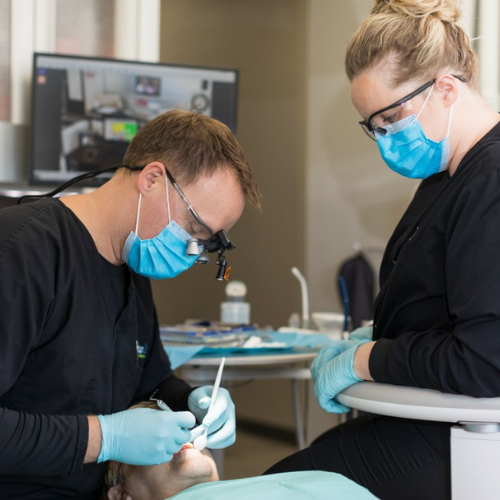General Dentistry
Restorative Dentistry
Cosmetic Dentistry
Root Canals
Some teeth may be too severely infected to be restored with a filling or even with a crown. Whether the tooth infection started with an injury or an untreated cavity, teeth with this depth of infection may require a root canal to save the remainder of the tooth. While root canals have a notorious reputation, the truth is that a root canal provides pain relief and preserves your tooth.
What is a Root Canal?
The dentists at Uptown Dental in Marion perform root canals to remove bacteria and the dying or dead tissue from inside a damaged tooth. Without this treatment, the tooth may have to be removed. Tooth extraction should be considered a last resort, as keeping a tooth in place is better for your jawbone and facial structure.
The root canal got its name from the technique dentists use to clean out the damaged tooth roots. Teeth are very hard on the outside, but inside, they are filled with living tissue called pulp. An infection can contaminate all of the tooth pulp, causing an abscess of infected material. This can in turn cause a lot of pain and swelling around the root of the tooth and in your jaw. To preserve the tooth, the dentist performs a root canal, cleaning out all of the infected material and packing it with a filling or capping it with a crown.
What to Expect
People think that a root canal is painful, but the process is much like getting a large filling. Your dentist will numb the areas of your mouth before working on accessing and cleaning out the tooth pulp. The procedure will take longer than a filling, but before you know it, the root canal will be complete.
Your dentist will then thoroughly rinse and dry the root canal areas and place medication in the canal as needed to clear up the infection. Your tooth may need to remain medicated for several days, so a temporary filling may be put in place. You should take care to avoid chewing with that tooth in order to protect it and allow it to heal.
Then, your dentist will fill the empty canal and fit it with a filling or crown. This may or may not require more anesthetic. A filling material is placed in the tiny root canals, and the tooth usually receives a crown to fully restore the top of the tooth.
If you ever have tooth pain, we encourage you to schedule a visit with Dr. Lenz or Dr. Mueller. By addressing tooth pain early, you could avoid a root canal or filling and preserve your teeth and smile. Please contact us to schedule an appointment.



